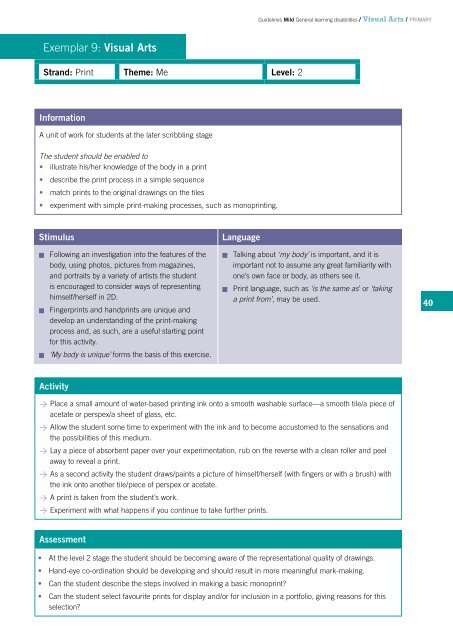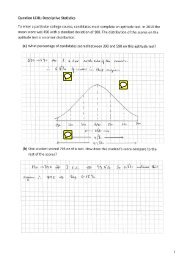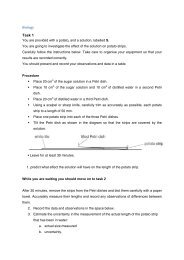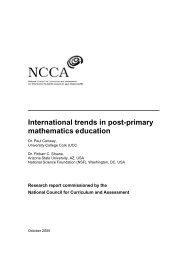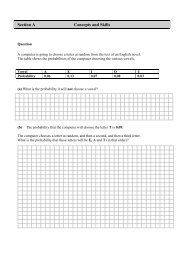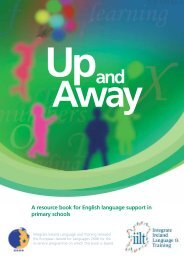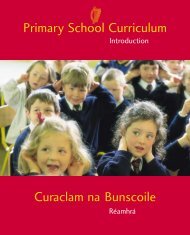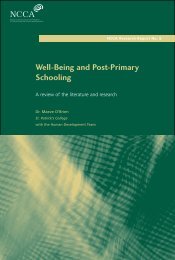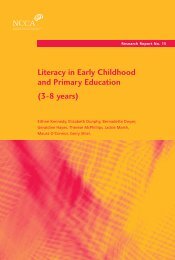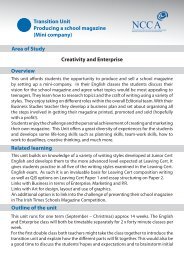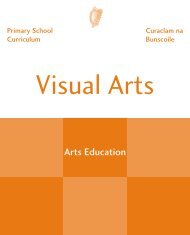Visual Arts - NCCA
Visual Arts - NCCA
Visual Arts - NCCA
You also want an ePaper? Increase the reach of your titles
YUMPU automatically turns print PDFs into web optimized ePapers that Google loves.
Exemplar 9: <strong>Visual</strong> <strong>Arts</strong><br />
Strand: Print Theme: Me Level: 2<br />
Information<br />
A unit of work for students at the later scribbling stage<br />
The student should be enabled to<br />
• illustrate his/her knowledge of the body in a print<br />
•<br />
•<br />
•<br />
describe the print process in a simple sequence<br />
match prints to the original drawings on the tiles<br />
experiment with simple print-making processes, such as monoprinting.<br />
Stimulus Language<br />
n<br />
n<br />
n<br />
Following an investigation into the features of the<br />
body, using photos, pictures from magazines,<br />
and portraits by a variety of artists the student<br />
is encouraged to consider ways of representing<br />
himself/herself in 2D.<br />
Fingerprints and handprints are unique and<br />
develop an understanding of the print-making<br />
process and, as such, are a useful starting point<br />
for this activity.<br />
‘My body is unique’ forms the basis of this exercise.<br />
Activity<br />
><br />
><br />
><br />
><br />
n<br />
n<br />
Guidelines Mild General learning disabilities / <strong>Visual</strong> <strong>Arts</strong> / PRIMARY<br />
Talking about ‘my body’ is important, and it is<br />
important not to assume any great familiarity with<br />
one’s own face or body, as others see it.<br />
Print language, such as ‘is the same as’ or ‘taking<br />
a print from’, may be used.<br />
Place a small amount of water-based printing ink onto a smooth washable surface—a smooth tile/a piece of<br />
acetate or perspex/a sheet of glass, etc.<br />
Allow the student some time to experiment with the ink and to become accustomed to the sensations and<br />
the possibilities of this medium.<br />
Lay a piece of absorbent paper over your experimentation, rub on the reverse with a clean roller and peel<br />
away to reveal a print.<br />
As a second activity the student draws/paints a picture of himself/herself (with fingers or with a brush) with<br />
the ink onto another tile/piece of perspex or acetate.<br />
> A print is taken from the student’s work.<br />
> Experiment with what happens if you continue to take further prints.<br />
Assessment<br />
•<br />
•<br />
•<br />
•<br />
At the level 2 stage the student should be becoming aware of the representational quality of drawings.<br />
Hand-eye co-ordination should be developing and should result in more meaningful mark-making.<br />
Can the student describe the steps involved in making a basic monoprint?<br />
Can the student select favourite prints for display and/or for inclusion in a portfolio, giving reasons for this<br />
selection?<br />
0


